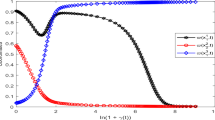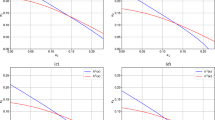Abstract
We consider a general formulation of the principal–agent problem with a lump-sum payment on a finite horizon, providing a systematic method for solving such problems. Our approach is the following. We first find the contract that is optimal among those for which the agent’s value process allows a dynamic programming representation, in which case the agent’s optimal effort is straightforward to find. We then show that the optimization over this restricted family of contracts represents no loss of generality. As a consequence, we have reduced a non-zero-sum stochastic differential game to a stochastic control problem which may be addressed by standard tools of control theory. Our proofs rely on the backward stochastic differential equations approach to non-Markovian stochastic control, and more specifically on the recent extensions to the second order case.
Similar content being viewed by others
Notes
For a recent different approach, see Evans et al. [19]. For each possible agent’s control process, they characterize contracts that are incentive compatible for it. However, their setup is less general than ours, and it does not allow volatility control, for example.
The ℙ-completion of \({\mathbb{G}}\) is defined for any \(t\in[0,T]\) by \(\mathcal{G}^{\mathbb{P}}_{t}:=\sigma(\mathcal{G}_{t}\cup \mathcal{N}^{\mathbb{P}})\), where \(\mathcal{N}^{\mathbb{P}}:=\{A\subseteq\Omega: {A\subseteq} B\text{ with }B\in{\mathcal{F}}_{T}\mbox{, }\mathbb{P}[B]=0\}\).
The ℙ-augmentation of \({\mathbb {G}}\) is defined by \(\mathcal{G}^{\mathbb{P}+}_{T}:=\mathcal{G}^{\mathbb {P}}_{T}\) and for any \(t\in[0,T)\) by \(\mathcal{G}^{\mathbb{P}+}_{t}=\bigcap _{s>t}{\mathcal{G}}_{s}^{\mathbb{P}}\).
The Brownian motion \(W^{\mathbb{M}}\) is defined on a possibly enlarged space if \(\widehat{\sigma}\) is not invertible ℙ-a.s. We refer to Possamaï et al. [32] for the precise statements.
The existing literature on the continuous-time principal–agent problem only addresses the case of drift control, so that admissible controls are described via equivalent probability measures. In our context, we allow volatility control, which in turn implies that our set \(\mathcal{P}\) is not dominated. It is therefore necessary for our approach to have a pathwise definition of stochastic integrals. Notice that the classical pathwise stochastic integration results of Bichteler [4] (see also Karandikar [24]) are not sufficient for our purpose, as we should need to restrict the process \(Z\) to have further pathwise regularity. The recent result of Nutz [29] is perfectly suitable for our context, but it uses the notion of medial limits to define the stochastic integral of any predictable process with respect to any càdlàg semimartingale whose characteristic triplet is absolutely continuous with respect to a fixed reference measure. The existence of medial limits is not guaranteed under the usual set-theoretic framework ZFC (Zermelo–Fraenkel axioms plus the uncountable axiom of choice), and further axioms have to be added. The continuum hypothesis is one among several sufficient axioms for existence of these limits to hold; see [32, Footnote 3] for a further discussion.
Those methods do not work for the general setup of the current paper, which provides a method for principal–agent problems with volatility choice that enables us to solve both the special, first best case of [7], and the second best, moral hazard case; the special case of moral hazard with CARA utility functions and linear output dynamics is solved using the method of this paper in Cvitanić et al. [9].
References
Aïd, R., Possamaï, D., Touzi, N.: Electricity demand response and optimal contract theory. Working paper (2017). Available online at: https://sinews.siam.org/Details-Page/electricity-demand-response-and-optimal-contract-theory-2
Beneš, V.E.: Existence of optimal strategies based on specified information, for a class of stochastic decision problems. SIAM J. Control 8, 179–188 (1970)
Beneš, V.E.: Existence of optimal stochastic control laws. SIAM J. Control 9, 446–472 (1971)
Bichteler, K.: Stochastic integration and \(L^{p}\)-theory of semimartingales. Ann. Probab. 9, 49–89 (1981)
Bolton, P., Dewatripont, M.: Contract Theory. MIT Press, Cambridge (2005)
Briand, P., Delyon, B., Hu, Y., Pardoux, É., Stoica, L.: \({L}^{p}\) solutions of backward stochastic differential equations. In: Stochastic Processes and Their Applications, vol. 108, pp. 109–129 (2003)
Cadenillas, A., Cvitanić, J., Zapatero, F.: Optimal risk-sharing with effort and project choice. J. Econ. Theory 133, 403–440 (2007)
Cheridito, P., Soner, H.M., Touzi, N., Victoir, N.: Second-order backward stochastic differential equations and fully nonlinear parabolic PDEs. Commun. Pure Appl. Math. 60, 1081–1110 (2007)
Cvitanić, J., Possamaï, D., Touzi, N.: Moral hazard in dynamic risk management. Manag. Sci. 63, 3328–3346 (2017)
Cvitanić, J., Wan, X., Zhang, J.: Optimal compensation with hidden action and lump-sum payment in a continuous-time model. Appl. Math. Optim. 59, 99–146 (2009)
Cvitanić, J., Zhang, J.: Contract Theory in Continuous-Time Models. Springer, Berlin (2012)
Dellacherie, C., Meyer, P.-A.: Probabilities and Potential A: General Theory. North-Holland, New York (1978)
Ekren, I., Touzi, N., Zhang, J.: Viscosity solutions of fully nonlinear parabolic path dependent PDEs: Part I. Ann. Probab. 44, 1212–1253 (2016)
Ekren, I., Touzi, N., Zhang, J.: Viscosity solutions of fully nonlinear parabolic path dependent PDEs: Part II. Ann. Probab. 44, 2507–2553 (2016)
El Karoui, N., Huu Nguyen, D., Jeanblanc-Picqué, M.: Compactification methods in the control of degenerate diffusions: existence of an optimal control. Stochastics 20, 169–219 (1987)
El Karoui, N., Peng, S., Quenez, M.-C.: Backward stochastic differential equations in finance. Math. Finance 7, 1–71 (1997)
El Karoui, N., Tan, X.: Capacities, measurable selection and dynamic programming. Part I: Abstract framework. Preprint (2013). Available online at: https://arxiv.org/pdf/1310.3363.pdf
El Karoui, N., Tan, X.: Capacities, measurable selection and dynamic programming. Part II: Application in stochastic control problems. Preprint (2015). Available online at: arXiv:1310.3364
Evans, L.C., Miller, C.W., Yang, I.: Convexity and optimality conditions for continuous time principal–agent problems. Preprint (2015). Available online at: https://math.berkeley.edu/~evans/principal_agent.pdf
Fleming, W.H., Soner, H.M.: Controlled Markov Processes and Viscosity Solutions, 2nd edn. Springer, New York (2006)
Haussmann, U.G., Lepeltier, J.-P.: On the existence of optimal controls. SIAM J. Control Optim. 28, 851–902 (1990)
Hellwig, M.F., Schmidt, K.M.: Discrete-time approximations of the Holmström–Milgrom Brownian-motion model of intertemporal incentive provision. Econometrica 70, 2225–2264 (2002)
Holmström, B., Milgrom, P.: Aggregation and linearity in the provision of intertemporal incentives. Econometrica 55, 303–328 (1987)
Karandikar, R.L.: On pathwise stochastic integration. In: Stochastic Processes and Their Applications, vol. 57, pp. 11–18 (1995)
Karatzas, I., Shreve, S.E.: Brownian Motion and Stochastic Calculus, 2nd edn. Springer, Berlin (1991)
Mastrolia, T., Possamaï, D.: Moral hazard under ambiguity. Preprint (2015). Available online at: arXiv:1511.03616
Müller, H.M.: The first-best sharing rule in the continuous-time principal–agent problem with exponential utility. J. Econ. Theory 79, 276–280 (1998)
Müller, H.M.: Asymptotic efficiency in dynamic principal–agent problems. J. Econ. Theory 91, 292–301 (2000)
Nutz, M.: Pathwise construction of stochastic integrals. Electron. Commun. Probab. 17, 1–7 (2012)
Nutz, M., van Handel, R.: Constructing sublinear expectations on path space. Stoch. Process. Appl. 123, 3100–3121 (2013)
Pardoux, É., Peng, S.: Adapted solution of a backward stochastic differential equation. Syst. Control Lett. 14, 55–61 (1990)
Possamaï, D., Tan, X., Zhou, C.: Stochastic control for a class of nonlinear kernels and applications. Annals of Probability (2015), forthcoming. Available online at: arXiv:1510.08439
Ren, Z., Touzi, N., Zhang, J.: Comparison of viscosity solutions of semi-linear path-dependent PDEs. Preprint (2014). Available online at: arXiv:1410.7281
Sannikov, Y.: A continuous-time version of the principal–agent problem. Rev. Econ. Stud. 75, 957–984 (2008)
Schättler, H., Sung, J.: The first-order approach to the continuous-time principal–agent problem with exponential utility. J. Econ. Theory 61, 331–371 (1993)
Schättler, H., Sung, J.: On optimal sharing rules in discrete- and continuous-time principal–agent problems with exponential utility. J. Econ. Dyn. Control 21, 551–574 (1997)
Soner, H.M., Touzi, N., Zhang, J.: Martingale representation theorem for the \({G}\)-expectation. In: Stochastic Processes and Their Applications, vol. 121, pp. 265–287 (2011)
Soner, H.M., Touzi, N., Zhang, J.: Quasi-sure stochastic analysis through aggregation. Electron. J. Probab. 16(67), 1844–1879 (2011)
Soner, H.M., Touzi, N., Zhang, J.: Wellposedness of second order backward SDEs. Probab. Theory Relat. Fields 153, 149–190 (2012)
Spear, S.E., Srivastava, S.: On repeated moral hazard with discounting. Rev. Econ. Stud. 54, 599–617 (1987)
Stroock, D.W., Varadhan, S.R.S.: Multidimensional Diffusion Processes. Springer, Berlin (1997)
Sung, J.: Linearity with project selection and controllable diffusion rate in continuous-time principal–agent problems. Rand J. Econ. 26, 720–743 (1995)
Sung, J.: Corporate insurance and managerial incentives. J. Econ. Theory 74, 297–332 (1997)
Sung, J.: Optimal contracting under mean-volatility ambiguity uncertainties. Preprint (2015). Available online at: https://papers.ssrn.com/sol3/papers.cfm?abstract_id=2601174
Williams, N.: On dynamic principal–agent problems in continuous time. University of Wisconsin (2009). Preprint. Available online at: http://www.ssc.wisc.edu/~nwilliam/dynamic-pa1.pdf
Author information
Authors and Affiliations
Corresponding author
Rights and permissions
About this article
Cite this article
Cvitanić, J., Possamaï, D. & Touzi, N. Dynamic programming approach to principal–agent problems. Finance Stoch 22, 1–37 (2018). https://doi.org/10.1007/s00780-017-0344-4
Received:
Accepted:
Published:
Issue Date:
DOI: https://doi.org/10.1007/s00780-017-0344-4
Keywords
- Stochastic control of non-Markov systems
- Hamilton–Jacobi–Bellman equations
- Second order backward SDEs
- Principal–agent problem
- Contract theory




